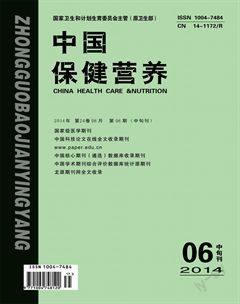青菜对餐后高血糖为主的新诊断2型糖尿病患者糖代谢的影响
罗长青等
【摘 要】目的:通过改善饮食结构,观察其对餐后高血糖为主的新诊断2型糖尿病患者的糖代谢的影响。方法:将我院内分泌科门诊就诊的明显以餐后血糖控制差为主的新诊断2型糖尿病患者60例,均无严重并发症,且肝肾功能正常,随机分为青菜组30例和阿卡波糖组30例,数据采用SPSS19.0软件进行统计学分析。结果:各组患者治疗2月后FPG、2hPPG、HbA1c与本组治疗前比较均有统计学意义(p<0.01),但两组之间治疗2月后FPG、2hPPG、HbA1c相比较均无统计学意义(p>0.05)。结论:每餐加用青菜可以改善餐后高血糖为主的新诊断2型糖尿病患者的糖代谢。
【关键词】糖尿病;蔬菜;阿卡波糖;血糖、糖化血红蛋白
【中图分类号】R581.2 【文章编号】1004-7484(2014)06-3458-02
【Abstract】Objective :To evaluate the influence of the changes in the dietary structure on the glycometabolism of the type 2 diabetic patients with increased postprandial blood glucose. Methods:60 type 2 diabetic patients with increased postprandial blood glucose in the endocrinology department,with no serious complication and normal hepatorenal function, were divided into vegetable group and Acarbose group randomly. The data were analyzed statistically with the help of SPSS19.0 software.Results:With two months treatment, the fasting plasma glucose (FPG),2h postprandial plasma glucose (2hPPG),and HbAlc of the patients of every group differ statistically(p<0.01), compared with the data from the same one collected before the treatment. But the FPG, 2hPPG and HbAlc of the patients of the two groups differ statistically,compared with the data collected after the two months treatment(p>0.05).Conclusion:Adding vegetables to meals can improve the glycometabolism of the type 2 diabetic patients with increased postprandial blood glucose.
【Key words】diabetes mellitus;vegetables;Acarbose;plasma glucose;glycosylated hemoglobin
2型糖尿病目前尚沒有根治的办法,需采取饮食、运动、药物、监测、教育五种治疗方案,其中饮食治疗是最基本的措施。饮食是否合理,直接影响到血糖控制的好坏。我们通过改善糖尿病患者的每餐饮食结构,取得了满意的效果,汇报如下。
1 对象与方法
1.1 对象 按1999年WHO诊断标准,将2013年8月-2014年3月在我院内分泌科门诊就诊的未用胰岛素或单一采取甘精胰岛素(来得时,Aventis Pharma Deutschland生产)使空腹血糖控制在5.5-8.0mmol/L之间,而餐后血糖控制差的新诊断2型糖尿病患者60例,均无严重并发症,排除孕产妇、感染、使用糖皮质激素以及心、肝、肾等脏器功能不全者。
40例患者随机分为2组:阿卡波糖组30例(男16例,女14例),年龄40~65岁;青菜组30例(男15例,女15例),年龄43~64岁。两组患者的性别、年龄均相似(P>0.05)。
1.2 方法.
1.2.1 治疗方法 对两组患者均进行科学的饮食及运动指导,并依据医学营养学原则计算热量,但对青菜组患者的每餐减少主食半份(45千卡),用相当热量的250克青菜替代,而对阿卡波糖组患者的每餐不加用或少用青菜,代之三餐时嚼服50mg阿卡波糖(拜唐苹,拜耳医药保健有限公司),并对其中使用甘精胰岛素者相应配备葡萄糖粉。给两组患者发放笔记本,记录每天的饮食、运动、用药情况及出现的不良反应,并要求患者每2周来医院门诊接受糖尿病健康教育指导。两组疗程均为2月。
1.2.2 检测指标及方法 检测所有患者治疗2月后空腹血糖(FBG)、早餐后2小时血糖(B-2hPBG)、糖化血红蛋白(HbA1c)。FBG、B-2hPBG采用葡萄糖氧化酶法测定,HbA1c采用高压液相离子交换法测定。
2 结果
2.1各组治疗前、后糖代谢相关指标变化 治疗2月后各组FBG(空腹血糖)、B-2hPBG(早餐后2小时血糖)、 HbA1c(糖化血红蛋白)与本组治疗前比较,均有统计学意义(均p<0.01)。
2.2 两组治疗2月后糖代谢相关指标变化 治疗2月后青菜组FBG(空腹血糖)、B-2hPBG(早餐后2小时血糖)、 HbA1c(糖化血红蛋白)与阿卡波糖组比较,均无统计学意义(p>0.05)。

